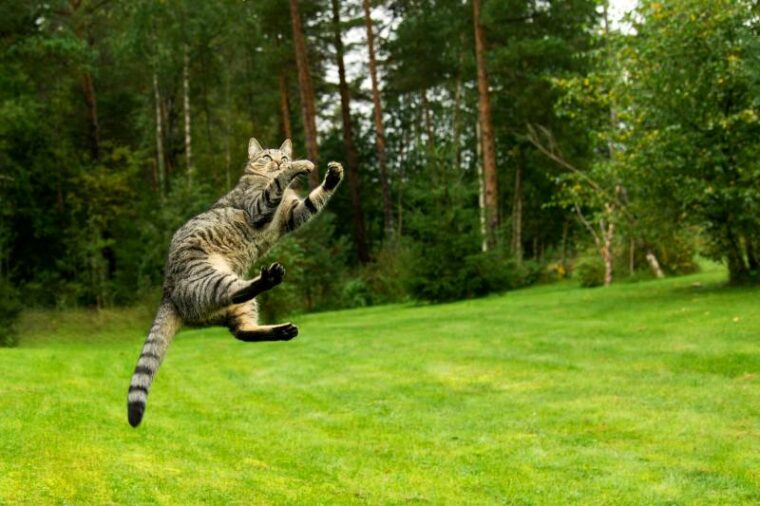
If you’ve owned cats for any length of time, you probably are well aware of how great at jumping they are. They’ll clear kitchen cupboards easily and often don’t let the highness of other tall surfaces, such as bookshelves, deter them from conquering new heights.
But how is it that such a small creature can jump so high? You can thank their physiology for that! Read on to learn more about how a cat’s body is designed to help them jump extremely high.
How Can Cats Jump So Well?
As hard as it may be to believe, all domesticated cats are direct descendants of the wildcat, a tree-dwelling species. These cats needed to evolve to jump swiftly to high perches to escape predators, rest, and observe the world around them. To become the incredibly talented hunters they were, they also needed to be able to jump, twist, and turn. While your cats don’t need to hunt to provide food for themselves or jump to escape predators, they’ve still retained many of the anatomical features of their wild ancestors.

What Physiological Features Help Cats Jump?
Powerful Hind Legs
A cat’s ability to jump high comes from their powerful hind leg muscles. Their strong and long hind legs and fast-twitch muscle fibers are designed to support quick bursts of movement. Additionally, the angle of their hind legs provides shock absorption for landing.
Stable Front Legs
A cat’s front legs play just as important a role in jumping as their back legs. When they jump, their front legs extend to reach toward what they’re jumping for the second their hind legs start to propel them forward. Their front legs provide much-needed stability.
Strong Muscles
Though they are much smaller than us, a cat’s body has just 100 fewer muscles than humans. Their muscle fibers are much stronger than ours, however, which is what gives them the ability to jump several times their own height, even from a seated position.

Flexible Spines
Cats have over 200 bones throughout their bodies, 23 of which are in their tail and 30 in their spine. Their highly flexible spines allow them to arch their bodies, providing the ability to course correct in the middle of their jumps. Also known as the “righting reflex”, this skill is what allows cats to orient themselves while falling so they land on their feet.
Strong Sense of Balance
Cat paws are cushiony and contain dozens of nerve receptors. These receptors allow them to assess which surface will be the best to jump from while also improving their balance. A cat’s inner ear system, tail, and flexible spine also help with balance.

How Far and High Do Cats Jump?
Healthy adult cats can jump vertically around five or six times their body length, anywhere between six and eight feet. Of course, every cat is different, and several factors can play a role in how far your cat can jump, including their age, breed, and health.
The longest horizontal jump by a cat, at least according to the Guinness Book of World Records, is 7 feet. This feat was achieved by a California kitty named Waffle the Warrior Cat in January 2018.
How High Can Cats Jump Compared to Other Animals?
It’s fascinating to compare the domestic cat’s jumping prowess with that of other animals, especially when we’re simultaneously comparing weight.
Take a look at this chart below to see just how accomplished your kitties are at jumping, taking their small weight into account.
| Animal | Average Weight | Vertical Jump Height |
| Cougar | 220 pounds | 18 feet |
| Serval | 26 pounds | 15 feet |
| Lion | 420 pounds | 12 feet |
| Bobcat | 40 pounds | 10 feet |
| Domestic cat | 10 pounds | 6 to 8 feet |
| Jaguarundi | 15 pounds | 6 feet |
Final Thoughts
Healthy adult cats can jump vertically six to eight feet, thanks to their unique body physiology. Their powerful legs, strong muscles, and flexible spines are just a small part of what makes cats such great jumpers. It’s these characteristics that also help cats reorientate themselves mid-air and land on their feet. Their bodies may be but little, but they sure are fascinating and capable of incredible things.
Featured Image Credit: Juhani Kovanen, Shutterstock






